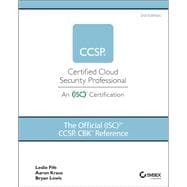The only official body of knowledge for CCSP—the most popular cloud security credential—fully revised and updated.
Certified Cloud Security Professional (CCSP) certification validates the advanced technical skills needed to design, manage, and secure data, applications, and infrastructure in the cloud. This highly sought-after global credential has been updated with revised objectives. The new third edition of The Official (ISC)2 Guide to the CCSP CBK is the authoritative, vendor-neutral common body of knowledge for cloud security professionals.
This comprehensive resource provides cloud security professionals with an indispensable working reference to each of the six CCSP domains: Cloud Concepts, Architecture and Design; Cloud Data Security; Cloud Platform and Infrastructure Security; Cloud Application Security; Cloud Security Operations; and Legal, Risk and Compliance. Detailed, in-depth chapters contain the accurate information required to prepare for and achieve CCSP certification. Every essential area of cloud security is covered, including implementation, architecture, operations, controls, and immediate and long-term responses.
Developed by (ISC)2, the world leader in professional cybersecurity certification and training, this indispensable guide:
- Covers the six CCSP domains and over 150 detailed objectives
- Provides guidance on real-world best practices and techniques
- Includes illustrated examples, tables, and diagrams
The Official (ISC)2 Guide to the CCSP CBK is a vital ongoing resource for IT and information security leaders responsible for applying best practices to cloud security architecture, design, operations and service orchestration.









